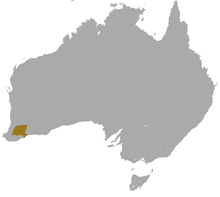Small brush tail bag
| Small brush tail bag | ||||||||||||
|---|---|---|---|---|---|---|---|---|---|---|---|---|

Small brushtail pouch ( Phascogale calura ) |
||||||||||||
| Systematics | ||||||||||||
|
||||||||||||
| Scientific name | ||||||||||||
| Phascogale calura | ||||||||||||
| Gould , 1844 |
The small brushtail butler ( Phascogale calura ) used to be widespread in Australia, east to the Murray River and the Darling River , but is now only found in a small area in southwestern Western Australia .
features
Males of the little brushtail butler have a head-trunk length of 10.5 to 12.2 cm, a 13.5 to 14.5 cm long tail and weigh 39 to 68 g. Females stay a little smaller with head and torso lengths of 9.3 to 10.5 cm, tail lengths of 11.9 to 14.4 cm and a weight of 38 to 48 g. The back of the animals is gray, the belly cream-colored to white. There are black spots in front of the eyes. The ears and the top of the body-hugging section of the tail are reddish, the rear tail section is black and bushy.
habitat
The small brush-tailed bucket still lives today in isolated patches of forest within a landscape largely characterized by wheat cultivation. He prefers forests with an annual rainfall of 300 to 600 mm and dense climax vegetation with tall trees (e.g. Eucalyptus wandoo , Eucalyptus loxophleba and Allocasuarina huegeliana ). Nests are built to rest in knotholes in the old trees. But the species can also be found along river banks, in bushland and on agricultural land.
Way of life
The small brushtail butler is mainly nocturnal and tree dwelling (arboreal). He can jump up to 2 meters. The animals also come to the ground in search of food, even during the day. They feed mainly on insects and spiders, but small birds, reptiles and mammals, including the house mouse introduced by humans, are also preyed on . Preference is given, however, to prey that is a maximum of 1 cm in size. Of the examined faecal samples of the species, 92.6% contained the remains of arthropods , 51.6% bird bones or feathers, one third contained the remains of small mammals and plant residues were present in 27.4% of the faecal samples. The small brushtail pouches only have one breeding season per year. This takes place synchronously for all animals within three weeks in July (Australian winter). Like the males of the broad-footed pouch mice ( Antechinus ), their sister species , the males die after copulation, which can take up to 6 hours. They reach a maximum age of 11.5 months. Females can also experience a second or third breeding season. They lived to be 5 years old in captivity. The gestation period is 28 to 30 days. The females can give birth to up to 13 young, of which a maximum of 8 survive to adulthood. They are 5 mm long and 15 mg in weight at birth and are suckled for about 90 days to weigh 20 g.
Danger
The small brush-tailed pouch can only be found on one percent of its original range today. Survival in this small area is possibly due to the legume genera Gastrolobium and Oxylobium that occur there , which are poisonous to numerous animals introduced by humans such as the red fox and house cat because of the fluoroacetates they contain , while native species such as the small brushtail pouch have a certain tolerance for the Have developed poison. Despite the small remaining distribution area, it is listed by the IUCN as Near Threatened, as the population is still over 10,000 adult animals. However, the population fluctuates greatly, depending on the annual rainfall.
Individual evidence
- ↑ a b c d e Andrew Baker: Family Dasyuridae (Carnivorous Marsupials). Page 324 in Don E. Wilson , Russell A. Mittermeier : Handbook of the Mammals of the World - Volume 5. Monotremes and Marsupials. Lynx Editions, 2015, ISBN 978-84-96553-99-6
- ↑ Phascogale Calura in the endangered Red List species the IUCN 2008. Posted by: Friend, T., 2008. Accessed March 22, 2018th

